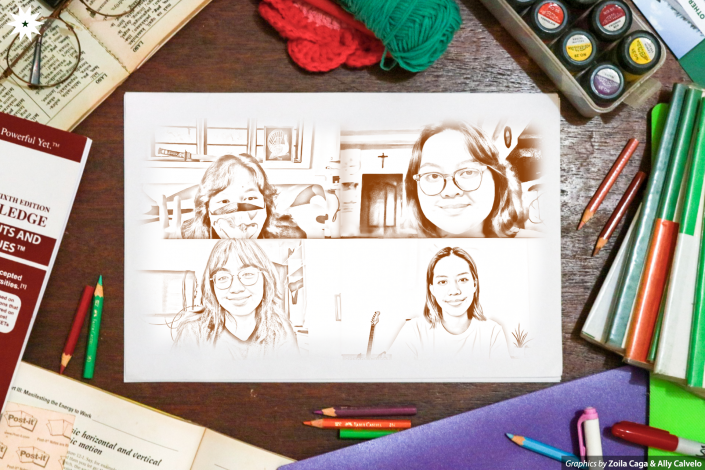Nothing can outshine the brilliance of a creative mind.
Even if the COVID-19 pandemic raises physical barriers around people, the imagination can still run to places one would never dare to dream. This was certainly true at the 36th DLSU Annual Awards for Literature (Litaw) and the 11th DLSU Annual Awards for Visual Arts (Visaw), held last Wednesday, March 2. Presented by Malate Literary Folio (MLF), the event recognized Lasallians from schools under De La Salle Philippines who proved their artistic excellence in both the literary and visual arts.

For the second year in a row, the event’s awarding ceremony was held via Zoom where it praised 62 works. Overall, the competition garnered 105 entries: 78 entries across six literary categories, namely Poetry, Short Story, Essay, Tula, Maikling Kuwento, and Sanaysay, and 27 entries from three visual arts categories—Traditional Art, Digital Art, Photography. The works were judged based on the mastery of technique, creativity, and impact.
“I was part actually of both the original face-to-face Litaw-Visaw, and also nung bagong transition,” Litaw-Visaw Technical Director and former MLF Externals Manager Dominique Yap explained. She further noted that despite the pandemic’s restrictions on physical events, these had little effect on their program. What’s important to them is that they upheld Litaw-Visaw’s goal, which former MLF Editor in Chief Cathleen Madrid described in her opening remarks, “[aims to] celebrate the thriving creativity of Lasallian artists.”
Everlasting moments
The event first awarded students who shone in the Literary categories. For the Poetry and Tula categories, the winning pieces gave readers a glimpse into the writers’ pasts. Adiella Domingo’s (II, ABLIM-CW) second-placing piece Sanciangco was named after a street near where she grew up. “I wrote this out of a heartbreak that I experienced. I sort of took that pain and converted it [into a work of art],” she briefly explained. Meanwhile, from De La Salle Lipa, Pia Concepcion Francisco’s piece titled Sa kaloob-looban ng iisang kwadrado—a heartful evocation of a passed loved one—won first place.
Meanwhile, winners in the Short Story and Maikling Kuwento categories focused on narratives that dug into the inner machinations of the country. In second place, To Bleed Is The Holiest Thing by Carlo Bautista (I, ABLIM-CW) honored the fallen members of the indigenous community as martyrs. “I want to commemorate the death of the lumads and that their deaths will always mean something,” he commented. In a different light, MLF Editor in Chief Lauren Angela Chua (II, AB-PHM) narrated the state of Philippine society during talks of lowering the criminal liability age in her piece titled Tumbang Preso, which placed second in the Maikling Kuwento category.
In the final two categories, the winning pieces ranged from the invigorating start of a new dream portrayed in The Devil Writes a Dream by Scianne Quiroz (II, ABLIM-CW) to the inquiries on overseas Filipino workers’ security in Isabell Richell Mendoza’s (IV, AB-CAM) 在家真的更安全吗?. Their commendable critiques bagged them third place in the Essay category and first place in the Sanaysay category, respectively.
The second half of the event was dedicated to traditional and digital artists who channeled their works around personal anecdotes. An example was Amelia Clarisse Monasteria’s (I, ABLIM-CW) Freedom, which won third place in the Digital Art category. “I [focused] on what freedom means as an individual, which means not caring about what people have to say about me,” she expressed.
Much of art does not only rely on the intention of the artist, but also on the message it sends to its audience. This is why many of Litaw-Visaw’s artists took inspiration from current events, providing social commentary on issues important to them. A notable example of this is the third place winner for Digital Art titled Standby by Dana Beatrice Tan (IV, IET-AD2), which discussed hopelessness and frustration toward Philippine authorities.
Beyond the pen and paintbrush
Overall, Litaw-Visaw highlighted the range of stories and messages that come from a pool of young and talented artists. In an interview with The LaSallian, former MLF Editor in Chief Paula Bianca Maraña (IV, AB-CAM)—who bagged awards for all five of their submissions—shared, “Allowing myself to be seen through these works was difficult because they’re all very personal.” However, they realized that through the majesty and musicality of art, the field became a gateway for them to release these emotions. “In that way, I could let them (their emotions) go and let myself heal,” they furthered.
Meanwhile, Mendoza shared similar sentiments, “Writing and creating art for me is an outlet of my emotions and thoughts.” “Turning the pain, the happiness, the madness, and the peace into art and the art will speak for itself,” she elaborated.
Many of the awardees’ entries were crafted with pieces of their hearts and souls, intertwined with imagination to create eye-catching mosaics of beauty in the struggle. Although this year’s Litaw-Visaw was held virtually, the winners’ statements about their art still bear an impact on the attendees—successfully expressing themselves through their work and sparking something meaningful. “If there is even one person that I can reach and resonate with, then that’s enough for me,” Maraña voiced out.
